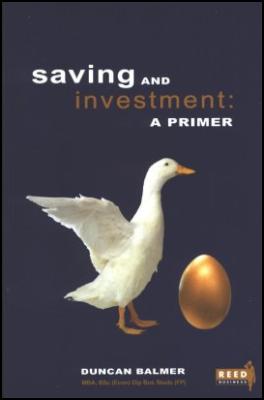Book Review: Saving and Investment: A Primer
BOOK REVIEW: Saving and Investment: A
Primer
By Duncan Balmer, Only $24.99
Reviewed by Mark Jory, on behalf of Good Returns
It is very obvious to most people that they need to save for their retirement - and that they need to be financially literate. This book is a clear, readable primer for savers and investors of all ages.
The aim of this book is “to provide sensible, well balanced advice and information on all aspects of savings and investment, so the reader can proceed in a safe and prudent manner.” It is targeted at the inexperienced investor of any age and attempts to provide a balanced viewpoint of savings and investment principles and the main types of investments available.
The book certainly achieves all this in a manner which is easy to follow and not too full of technical jargon (though a useful glossary is included). It is an easy read and I got through most of the book within a day, indicating that the information is provided in a manner which is fairly easy to follow.
The book is split into three parts, saving and investment basics, borrowing to invest, and how to invest successfully, followed by further information on the topics of how much capital you need in retirement, types of investments, and the advantages and disadvantages of indirect investing. The author has also been thoughtful enough to include further recommended reading and useful websites, as well as an index.
Throughout the book a fine balance has been maintained between describing an investment and its pro’s and con’s without being overly negative or positive and letting any personal bias show through. I got the impression that the author feels too many people invest in fixed interest investments or residential property as there is perhaps more detailed information on why these investments are not necessarily better than any other investment.
The valid point is made that borrowing to invest in property is essentially no different than borrowing to invest in any other asset, the success of the investment is not due to any tax advantages created through borrowing, but through the quality of the asset itself and how you manage it.
The advice given in this book is straightforward and simple to understand. For example, Chapter 2 – How to save. “Spend less than you earn”. And of course it is essentially is as simple as that isn’t it. Chapter 2a does provide more detail on saving, and the author hasn’t been afraid to tell people realities like the real cost of debt, e.g. a $2,000 sounds system at 12% over two years actually costs you $2,237!
I found the book loaded with useful information and balanced viewpoints in most instances, though perhaps a little negative on equity release and rental property, but I feel it would be difficult for anyone to not let a little bias into this topic.
If you know a bit about investing then this book might not provide much new information for you but would still challenge you to re-examine your spending, budgeting, and the reasons behind the investment decisions you have made. However it is really the ideal book to give someone starting their first full time job and would also prove to be a useful textbook (primer) for secondary school students. I would recommend this book to anyone wanting to find out the basics of investing from one single source, that applies to the New Zealand investor, and is easy to read and understand.
Savings and Investment: A Primer is available through the Good Returns Bookstore (www.goodreturns.co.nz/books or call 0800 345 675)
Link:
Saving and Investment: A
Primer



 Eugene Doyle: The Fall Of Saigon 1975 - Fifty Years Of Repeating What Was Forgotten
Eugene Doyle: The Fall Of Saigon 1975 - Fifty Years Of Repeating What Was Forgotten Peter Dunne: Dunne's Weekly - Trump's Tariffs Still Pose Risks For New Zealand
Peter Dunne: Dunne's Weekly - Trump's Tariffs Still Pose Risks For New Zealand Keith Rankin: Barbecued Hamburgers And Churchill's Bestie
Keith Rankin: Barbecued Hamburgers And Churchill's Bestie Gordon Campbell: On Why The US Stands To Lose The Tariff Wars
Gordon Campbell: On Why The US Stands To Lose The Tariff Wars Eugene Doyle: Before It’s Too Late - Reimagine New Zealand’s Military Future
Eugene Doyle: Before It’s Too Late - Reimagine New Zealand’s Military Future  Binoy Kampmark: Gender Stunts In Space - Blue Origin’s Female Celebrity Envoys
Binoy Kampmark: Gender Stunts In Space - Blue Origin’s Female Celebrity Envoys